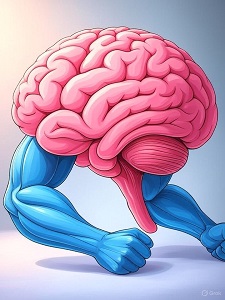
1. Enhanced Neuroplasticity
- Explanation: Neuroplasticity refers to the brain’s ability to adapt, reorganize, and form new neural connections throughout life. Exercise promotes neuroplasticity by stimulating the growth of new neurons (neurogenesis) and strengthening synaptic connections. This is particularly evident in the hippocampus, a brain region critical for learning and memory.
- Mechanism: Physical activity increases the production of brain-derived neurotrophic factor (BDNF), a protein that supports neuron growth, survival, and synaptic plasticity. Aerobic exercises, such as running or cycling, have been shown to elevate BDNF levels, enhancing the brain’s ability to adapt to new challenges and learn new skills.
- Impact: Improved neuroplasticity enhances cognitive flexibility, problem-solving, and the ability to acquire new knowledge. It also supports recovery from brain injuries and slows age-related cognitive decline.
2. Improved Memory and Learning
- Explanation: Exercise directly benefits memory and learning by enhancing the structure and function of the hippocampus. This brain region is essential for forming and retrieving memories, particularly declarative memories (facts and events).
- Mechanism: Aerobic exercise increases hippocampal volume and improves its connectivity with other brain regions. It also boosts blood flow, delivering oxygen and nutrients that support memory consolidation. Studies show that regular exercise improves performance on tasks requiring verbal memory, spatial memory, and associative learning.
- Impact: Enhanced memory and learning abilities benefit academic performance, professional tasks, and daily activities. For example, students who exercise regularly tend to perform better on tests, and older adults can maintain sharper memory with consistent physical activity.
3. Reduced Stress and Anxiety
- Explanation: Exercise acts as a natural stress reliever by modulating the brain’s stress response systems. It reduces levels of stress hormones like cortisol and promotes a sense of calm and well-being.
- Mechanism: Physical activity stimulates the release of endorphins, serotonin, and dopamine—neurotransmitters that regulate mood and reduce anxiety. It also activates the parasympathetic nervous system, which counteracts the “fight-or-flight” response. Activities like yoga and moderate aerobic exercise are particularly effective at lowering stress.
- Impact: Lower stress and anxiety levels improve mental clarity, emotional resilience, and overall psychological health. This can lead to better decision-making and reduced risk of stress-related disorders like anxiety or depression.
4. Improved Mood and Emotional Regulation
- Explanation: Exercise has a powerful antidepressant effect, improving mood and helping individuals manage emotions more effectively. It is often recommended as a complementary therapy for mood disorders.
- Mechanism: Physical activity increases the availability of serotonin, dopamine, and norepinephrine in the brain, which are critical for mood regulation. It also reduces activity in the amygdala, the brain region associated with fear and emotional reactivity. Regular exercise promotes a positive emotional state and resilience against negative emotions.
- Impact: Improved mood enhances social interactions, productivity, and overall quality of life. Exercise can serve as a non-pharmacological intervention for individuals with mild to moderate depression or mood swings.
5. Enhanced Executive Function
- Explanation: Executive functions are higher-order cognitive processes, including planning, decision-making, problem-solving, and impulse control, primarily managed by the prefrontal cortex. Exercise strengthens these abilities, leading to better cognitive control.
- Mechanism: Aerobic exercise increases blood flow to the prefrontal cortex, enhancing its activity and connectivity with other brain regions. It also promotes the release of neurotrophic factors like BDNF, which support the growth and maintenance of neurons in this area. Studies show that even a single session of exercise can improve executive function temporarily.
- Impact: Enhanced executive function improves productivity, goal-setting, and the ability to manage complex tasks. This is particularly beneficial in high-demand environments like workplaces or academic settings.
6. Increased Attention and Focus
- Explanation: Exercise improves attention span and the ability to concentrate by enhancing activity in brain regions responsible for focus, such as the prefrontal cortex and parietal cortex.
- Mechanism: Physical activity increases levels of dopamine and norepinephrine, neurotransmitters that regulate attention and alertness. It also reduces mental fatigue by improving cerebral blood flow and oxygenation. Activities like team sports or high-intensity interval training (HIIT) are particularly effective at boosting focus.
- Impact: Improved attention and focus enhance performance in tasks requiring sustained concentration, such as studying, working, or driving. This effect is especially pronounced in individuals with attention disorders like ADHD.
7. Protection Against Cognitive Decline
- Explanation: Regular exercise reduces the risk of age-related cognitive decline and neurodegenerative diseases like Alzheimer’s and Parkinson’s by preserving brain structure and function.
- Mechanism: Exercise promotes neurogenesis, reduces inflammation, and enhances antioxidant defenses in the brain, protecting neurons from oxidative stress and damage. It also improves vascular health, ensuring adequate blood supply to the brain. Long-term exercise is associated with larger brain volumes in areas like the hippocampus and prefrontal cortex.
- Impact: By slowing cognitive decline, exercise helps maintain mental sharpness in older adults, supporting independent living and reducing the risk of dementia. Even moderate activities like walking can have significant protective effects.
8. Improved Sleep Quality
- Explanation: Exercise promotes better sleep by regulating the brain’s circadian rhythms and reducing sleep-disrupting factors like stress and anxiety.
- Mechanism: Physical activity increases the production of adenosine, a neurotransmitter that promotes sleepiness, and regulates the body’s internal clock. It also reduces cortisol levels, which can interfere with sleep. Morning or afternoon exercise is particularly effective at improving sleep onset and duration.
- Impact: Better sleep quality enhances cognitive performance, memory consolidation, and emotional well-being. It also reduces the risk of sleep disorders like insomnia, which can negatively affect brain health.
9. Increased Creativity and Problem-Solving
- Explanation: Exercise stimulates creative thinking and enhances the ability to solve problems by fostering divergent thinking and cognitive flexibility.
- Mechanism: Physical activity increases activity in the default mode network (DMN), a brain network associated with creativity and imagination. It also improves connectivity between brain regions involved in idea generation and problem-solving. Activities like walking or moderate aerobic exercise have been shown to boost creative output.
- Impact: Enhanced creativity benefits fields like art, innovation, and strategic planning. For example, individuals may find novel solutions to challenges or generate more original ideas after exercise.
10. Improved Brain Energy Metabolism
- Explanation: Exercise optimizes the brain’s energy use by improving the efficiency of glucose and oxygen metabolism, which are critical for cognitive function.
- Mechanism: Physical activity enhances mitochondrial function in brain cells, increasing energy production. It also improves insulin sensitivity, ensuring stable glucose levels for the brain. Aerobic exercise increases cerebral blood flow, delivering more oxygen and nutrients to support metabolic demands.
- Impact: Improved brain energy metabolism enhances mental stamina, reduces cognitive fatigue, and supports sustained cognitive performance during demanding tasks. This is particularly beneficial for individuals with high cognitive workloads.




